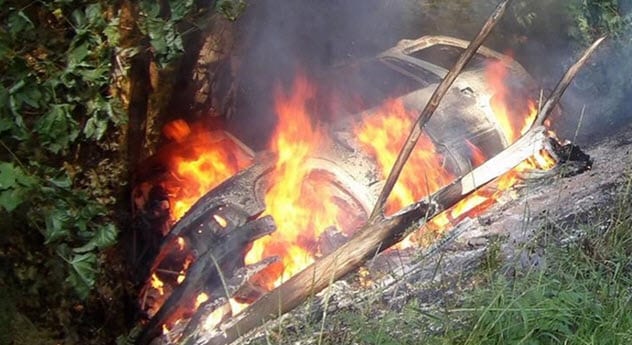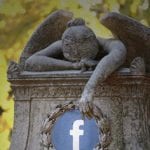 Miscellaneous
Miscellaneous  Miscellaneous
Miscellaneous  History
History 10 Huge Historical Events That Happened on Christmas Eve
 Music
Music 10 Surprising Origin Stories of Your Favorite Holiday Songs
 History
History 10 Less Than Jolly Events That Occurred on December 25
 Weird Stuff
Weird Stuff 10 Funny Ways That Researchers Overthink Christmas
 Politics
Politics 10 Political Scandals That Sent Crowds Into the Streets
 Weird Stuff
Weird Stuff Ten Bizarre Facts About The Doge Meme
 Our World
Our World 10 Ways Your Christmas Tree Is More Lit Than You Think
 Movies and TV
Movies and TV The 10 Coolest Stars to Set Sail on The Love Boat
 History
History 10 Things You Didn’t Know About the American National Anthem
 Miscellaneous
Miscellaneous Top 10 Things Crypto Was Supposed to Change & What Actually Did
 History
History 10 Huge Historical Events That Happened on Christmas Eve
 Music
Music 10 Surprising Origin Stories of Your Favorite Holiday Songs
Who's Behind Listverse?

Jamie Frater
Head Editor
Jamie founded Listverse due to an insatiable desire to share fascinating, obscure, and bizarre facts. He has been a guest speaker on numerous national radio and television stations and is a five time published author.
More About Us History
History 10 Less Than Jolly Events That Occurred on December 25
 Weird Stuff
Weird Stuff 10 Funny Ways That Researchers Overthink Christmas
 Politics
Politics 10 Political Scandals That Sent Crowds Into the Streets
 Weird Stuff
Weird Stuff Ten Bizarre Facts About The Doge Meme
 Our World
Our World 10 Ways Your Christmas Tree Is More Lit Than You Think
 Movies and TV
Movies and TV The 10 Coolest Stars to Set Sail on The Love Boat
 History
History 10 Things You Didn’t Know About the American National Anthem
Top 10 Terrible Tragedies Of The Boy Scouts
Founded in 1910, the Boy Scouts of America currently has over 2.4 million youth participants and about one million adult volunteers. The organization prides itself on instilling a moral compass in its youthful members as well as helping them to participate in various outdoor activities.
See Also: 10 Dark Origins of Beloved Organizations
From camping and hiking to aquatics and fire building, such undertakings come with risks. Through the years, these activities have cost many lives. Here, we’ll look at some horrors that have befallen unsuspecting, adventure-seeking Scouts and their leaders in some of the most unforeseeable circumstances.
10 Freak Accidents

On the first day of the 2005 National Scout Jamboree in Virginia, four Boy Scout leaders took on the physical task of erecting a dining tent. Moments later, a weekend that was supposed to be filled with festivity turned tragic.
As the men were raising one of the metal poles, it tilted and struck a power line, setting ablaze the entire pavilion. While their children and fellow Scouts looked on in horror, the canvas—engulfed in flames—encased the men within the inferno. On that dreadful afternoon, Michael J. Shibe (49), Ronald H. Bitzer (58), Scott E. Powell (57), and Michael Lacroix (42) perished amid their loved ones.
Their deaths were eerily similar to those of three Boy Scouts in 2017 after their sailboat struck an overhead power line in East Texas. The boys—Thomas Larry (11), Heath Faucheux (16), and William Brannon (17)—were just offshore when the incident set their boat on fire.[1]
Unfortunately, freak accidents among the Scouts are more commonplace than we may realize.
Case in point: In October 2018, a 12-year-old Michigan boy was buried alive while tunneling through a sand dune. Four months earlier, a 14-year-old Scout in Georgia was killed when a tree snapped in 80 kilometer-per-hour (50 mph) winds. It fell on his tent and crushed him.
The teen’s death was nearly identical to the tragedy that befell a 13-year-old boy and a 29-year-old volunteer in July 2016 when high winds caused a tree to fall in their camp. From drunk drivers plowing through hiking expeditions to flash floods sweeping Scout leaders and children to their deaths, exploring the great outdoors undeniably comes with risks.
9 Branding Recreations

In the Boy Scouts, it is common practice for adult leaders (who act as role models and mentors) to create their own activities within the troop. Such recreation can include camping trips, community service, and leadership activities.
In 1982, two Scout leaders from Missouri had a different notion when it came to insightful guidance and growth. While on a weekend campout in Huntsville, J.B. Gatzmeyer, 37, and Kenneth Willard, 19, had the bright idea to leave a lasting impression on seven boys whose ages ranged from 11 to 15.
Armed with a heated coat hanger twisted into the shape of male genitalia, Willard branded the buttocks of six of the boys—with one receiving brands on both arms—while Gatzmeyer sat on their legs. Evidently, the two stooges with an odd sense of humor said that the boys would be banned from future outings if they did not participate in the branding.
Gatzmeyer and Willard topped off the evening by giving each other brands on their own rear ends.[2]
Of all the Scouts, the 11-year-old refused to participate. Even after threats of castration, the boy stood his ground. Although he left without a new tattoo, he probably arrived home with some psychological damage.
Ultimately, each of the so-called “mentors” was convicted of assault and related charges and sentenced to one year in prison. For unspecified medical reasons, Gatzmeyer was released after serving just three months.
8 Routine Tragedy

In summer 1982, 29 Boy Scouts and adults set out on an expedition around and on the mountain lakes in southeastern British Columbia. Unexpectedly, a storm swept through the region while the boys and their Scout leaders were rowing through the waters of Lake McNaughton.
In the aftermath of the downpour, two canoes were lost along with their occupants. Following a lengthy air search, the bodies of four teenage American Scouts and two adults were pulled from the icy waters. They were still wearing their life jackets.
Sadly, drowning is a common occurrence in the organization. Between 2005 and 2010, several Scouts drowned while partaking in outdoor activities. In fact, within the same time span, a total of 32 boys, leaders, and invited guests were killed.[3]
The majority of these deaths were attributed to blunt force head trauma due to falling trees, rocks, and even totem poles. Lightning strikes, severe burns, and hyperthermia have also been factors on several occasions. Although the Boy Scouts have taken drastic measures to ensure the safety of their members, freak accidents and unforgiving Mother Nature have continued to produce tragedies over the last 100 years.
7 Nowhere To Run

On June 11, 2008, an EF3 tornado descended on the Little Sioux Scout Ranch in western Iowa with winds of 233 kilometers per hour (145 mph). In a state of hysteria, all Scouts were ordered to take refuge in their cabins because there were no basements or in-ground shelters.
As the tornado hit, one cabin was leveled, causing the brick chimney to collapse onto the boys. Overall, more than 40 individuals were injured. Many sustained broken bones that required multiple surgeries and months of rehabilitation.
Sadly, four teenage Scouts—Ben Petrzilka, Sam Thomsen, Josh Fennen, and Aaron Eilerts—perished after being crushed by falling concrete and debris. The survivors described “scenes of chaos” that attracted the attention of local and national media outlets.
In the months following, the parents of the deceased boys and some of the surviving Scouts were invited to the White House, where they met then-President George W. Bush. Over the next five years, the camp constructed two concrete tornado shelters with steel doors built to withstand an EF5 tornado. Today, a chapel sits on the site where the four boys lost their lives.[4]
6 Unanswered Heartache

Returning home from a church-sponsored camping trip in Blackstone, Virginia, four Boy Scouts were passengers in an SUV driven by Scoutmaster John Oliver. It was November 5, 2006, and weather conditions were clear and calm with no foreseeable dangers.
For reasons that remain unknown, Oliver, 43, veered off the road and struck a large maple tree in Southampton County. The road was unremarkable other than a slight curve that did not require a car to slow down from the posted “55 mph” speed limit.
The explosion from the crash drew locals out of their homes. They rushed to the scene to find 12-year-old Michael-John Oliver, the son of the driver, lying on the asphalt. With a broken leg, Michael-John had summoned the strength to crawl from the burning vehicle before it burst into flames.
As the boy waited with bystanders for first responders to arrive, Luke Drewry (12), Jackson Fox (13), Carter Stephenson (14), and Michael-John’s father, John, remained trapped inside, where they perished. Parents awaiting the arrival of their children from the retreat were at church when they received the heartbreaking news that their sons would not be coming home.
Reports indicate that Oliver—a former Marine who had survived a 1983 bombing in Beirut that killed 241 of his fellow US servicemen—had no difficulties navigating earlier curves. Authorities “don’t know why he didn’t negotiate the curve.”[5]
5 Circle Of Fire

Flammable liquids used as fire starters have been prohibited by the Boy Scouts since the organization’s inception. Whenever a fire is necessary, two adults are required to supervise. Such standards were neglected on the evening of July 6, 2008, at the Joseph A. Citta Reservation in Waretown, New Jersey.
That evening, 18-year-old Eagle Scout Brian Lenz was showing off to a group of Scouts a trick he called “circle of fire.” Channeling his inner Houdini, Lenz squirted rubbing alcohol in a pattern on a table and then set it alight. Believing that the flame was dying, the Eagle Scout poured on more alcohol. Within a second, the liquid stream caught fire and found its way back to the bottle he was holding.
Lenz was frantically waving his hand in a futile attempt to extinguish the burning bottle when he released the firestorm onto the other Scouts. An explosion ensued, severely burning three boys. One of them, 17-year-old Sean Whitley, succumbed to his injuries four days later.
In the aftermath, Lenz pleaded not guilty to third-degree aggravated assault and struck a deal allowing him to enter a pretrial intervention program. In doing so, he avoided jail time as well as any criminal record.
When all was said and done, Lenz left the Ocean County Superior Court “smiling and in high spirits.” To add insult to injury, he was not stripped of his status as an Eagle Scout. According to Scout executive Craig H. Shelley, “When a boy earns Eagle Scout, he does that on his own. They maintain it forever, so he is still an Eagle Scout.”[6]
4 A Wrong Turn

On November 15, 1958, six Boy Scouts set out on a hike in the Santa Rita Mountains south of Tucson. The temperature was comfortably warm with calm winds and no chance of rain. It was supposed to be a scenic, joyous occasion for the kids who were celebrating the 12th birthday of fellow Scout David Greenberg.
At some point in their journey up the mountain, three Scouts decided to head back down due to fatigue. It was the last time that anyone saw them alive. At the time, methods of weather forecasting were unsophisticated and they missed an approaching storm.
It ravaged the terrain and changed the lives of three families forever. As the sun set, the winds kicked up and showers poured from the sky. By midnight, several feet of snow blanketed the trails, the landmarks, and the bodies of the three boys.[7]
In the days that followed, approximately 700 volunteers scoured the area in a fruitless effort that brought no closure. Nineteen days later, on December 4, a rancher tending to his land confirmed everyone’s worst fear.
Lost and unprepared for the subfreezing temperatures, Mike Early, Michael LaNoue, and birthday boy David Greenberg had frozen to death. Their bodies were carried off the mountain by soldiers from Fort Huachuca who stacked rocks and erected crosses where the boys’ lives had tragically come to an end.
3 Knife-Wielding Paranoid Schizo

In August 2011, Valerie Henson of northern Indiana called 911 to report that her son, 22-year-old Shane Golitko, had assaulted her in the home they shared. With a broken arm, Henson fled to a neighbor’s house while her crazed son grabbed a large knife and took off into the woods.
At that time, 76-year-old Arthur L. Anderson was leading a hiking trip near Bunker Hill when he stopped the young Scouts to discuss a particular tree. Moments later, the knife-wielding lunatic emerged from the brush and plunged the 30-centimeter (12 in) knife into Anderson’s neck.[8]
As suddenly as he had appeared, Golitko vanished. The boys were physically unharmed yet horrified as they watched their beloved Scout leader bleed to death right before their eyes.
Returning home, Golitko stabbed his two dogs, broke windows, and trashed the entire house before escaping in his mother’s Jeep. A 13-kilometer (8 mi) chase with police ensued before he was finally apprehended.
Diagnosed as a paranoid schizophrenic, Golitko claimed that he had stopped taking his antipsychotic medications. After pleading guilty but mentally ill to murder, he was sentenced to 45 years in prison.
2 Alone In A Tent

On April 24, 1970, six instructors and 24 boys arrived on the expansive grounds of St. Basil the Great Catholic Church in Pennsylvania. About 183 meters (600 ft) from the church buildings, the group of wide-eyed young children enjoying the beauty of spring had set up camp while blissfully anticipating the weekend ahead.
All innocence ended less than 48 hours later. In the early morning hours of April 26, the lifeless body of 11-year-old Terry Bowers was discovered. Alone in his tent, the boy had been stabbed four or five times while lying in his green sleeping bag. The sheer brutality was almost as incomprehensible as the reason why someone would commit such a monstrous and senseless murder.[9]
The only break for detectives came from Lawrence Wakely, a former Scout and convicted rapist. Speaking to authorities, the mentally ill Wakely admitted to killing Bowers in retaliation for being kicked out of the Boy Scouts a decade earlier.
Upon further questioning, however, Wakely could not respond to questions that only the killer would have been able to answer. After being ruled out as a suspect, the case went cold again and has remained so for the last several decades.
1 ‘The Killer Was Here’

The night was riddled with eerie happenings. From shadowy figures and strange noises to faint screams and cries, the Girl Scout Camp outside Locust Grove, Oklahoma, will forever be remembered as a place of horrors. Though we’ve focused on the Boy Scouts until now, what happened to three girls in the middle of the night four decades ago continues to haunt countless residents.
In the early morning hours of June 13, 1977, a counselor walking the campgrounds discovered the body of 10-year-old Doris Milner sprawled along a dirt trail. Nearby lay Lori Farmer, 8, and Michelle Guse, 9, dead inside their zipped sleeping bags a short distance from their tent. Two of the girls had been beaten to death while the other had been strangled. All three had been sexually assaulted.[10]
Three K9s hailed as “wonder dogs” were rushed in from other states to aid in the investigation but were of no help. The sinister atmosphere was compounded when one of the dogs was killed after inexplicably dashing onto the road while another died of heatstroke.
Scrawled on the wall of a nearby cave, searchers discovered the taunting message, “77-6-17. The killer was here. Bye Bye fools.” In the end, the only piece of evidence recovered was a single hair found on the body of one of the girls. Analysis suggested that it was from a Native American.
This led sheriffs to Gene Hart, a Cherokee fugitive with a lengthy rap sheet. In 1966, Hart had received three 10-year sentences for raping two pregnant women, but he was paroled in 1969. Less than three months later, he was back in jail for burglary. But he escaped in 1973.
Hart remained in hiding until April 1978 when police tracked him to a remote tar paper shack. His trial began a year later and ended with a not guilty verdict because the evidence “didn’t add up” to the jury.
Even so, Hart was sent back to prison following his trial to serve more than 300 years for earlier crimes. In June 1979, he died in prison after suffering a heart attack at age 35. To date, the brutal murders of Doris, Lori, and Michelle remain unsolved.
For more lists like this, check out 10 Ways You Can Legally Discriminate In The USA and Top 10 Tales Of Children Lost In The Wilderness.

![Top 10 Haunting Images Of Historic Tragedies [DISTURBING] Top 10 Haunting Images Of Historic Tragedies [DISTURBING]](https://listverse.com/wp-content/uploads/2020/05/33758v-150x150.jpg)






